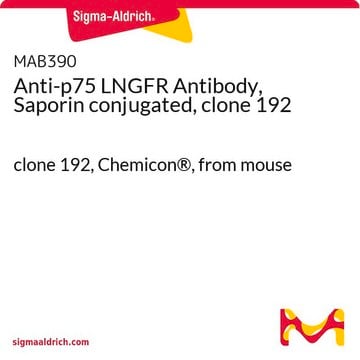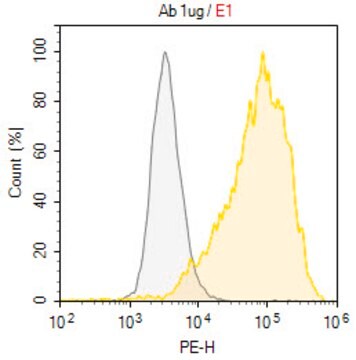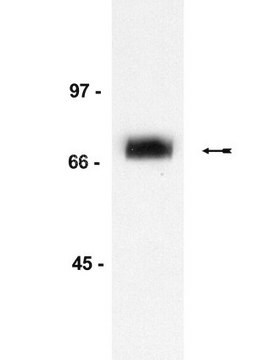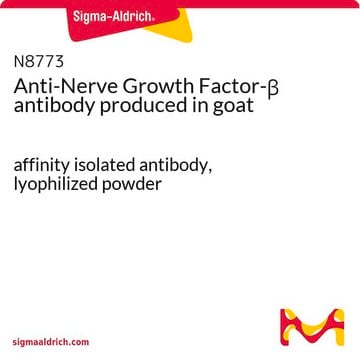推荐产品
生物源
mouse
共軛
unconjugated
抗體表格
ascites fluid
抗體產品種類
primary antibodies
無性繁殖
ME20.4, monoclonal
分子量
antigen 75 kDa
包含
15 mM sodium azide
物種活性
racoon, monkey, pig, human, feline
應無反應活性
mouse, chicken, rat
技術
flow cytometry: suitable
immunohistochemistry (formalin-fixed, paraffin-embedded sections): 1:1,000 using human tongue
immunohistochemistry (frozen sections): suitable
immunoprecipitation (IP): suitable
indirect ELISA: suitable
microarray: suitable
neutralization: suitable
radioimmunoassay: suitable
western blot: suitable
同型
IgG1
UniProt登錄號
運輸包裝
dry ice
儲存溫度
−20°C
目標翻譯後修改
unmodified
基因資訊
human ... NGFR(4804)
一般說明
Monoclonal Anti-Nerve Growth Factor Receptor (NGFR p75) (mouse IgG1 isotype) is derived from the ME20.4 hybridoma produced by the fusion of mouse myeloma cells and splenocytes from a BALB/c mouse immunized with a human melanoma cell line WM245. The human NGFR p75 has a hydrophobic signal sequence, a single N-linked glycosylation site, four cysteine-rich repeat units of approximately 40 amino acids in the extracellular domain, a serine- and threonine-rich region which might be O-linked glycosylated, a single transmembrane domain, and a 155-amino acid cytoplasmic domain.
Recognizes the low affinity human NGFR p75 (also known as gp75NGFR , p75NGFR and p75NTR). The epitope recognized by the antibody exists within the third or fourth cysteine-rich repeats of the NGFR molecule.
特異性
Monoclonal Anti-Nerve Growth Factor Receptor (NGFR p75) recognizes the low affinity NGFR p75 of human origin (75 kDa), also known as gp75NGFR, p75NGFR and p75NTR .The epitope recognized by the antibody is located within the third or fourth cysteine-rich repeats of the NGFR molecule. Cross-reactivity has been observed with human, monkey (marmoset), pig, cat and raccoon , but not with rat, chicken or mouse NGFR.
免疫原
human melanoma cell line WM245.
應用
Monoclonal Anti-Nerve Growth Factor Receptor (NGFR p75) antibody produced in mouse has been used in immunoblotting. to added in CB.
Monoclonal Anti-Nerve Growth Factor Receptor (NGFR p75) may be used:
- for enzyme linked immune sorbent assay (ELISA)
- immunoprecipitation, immunoblotting and immunohistochemistry
- for immunocytochemistry (acetone- or formalin-fixed, Bouin′s solution - or formalin- fixed paraffin-embedded)
- for electron- microscopy radioimmunoassay (RIA) (Kd of 7x10-10 M)
- flow cytometry
- for the inhibition of binding of NGF to the receptor
- for rossette assay
- as a cholinergic immunotoxin
生化/生理作用
Nerve Growth Factor Receptor (NGFR) p75 enhances the NGF binding affinity of the proto-oncogene product p140trk and also may modulate the kinase activity of p140trk and play a role in signal transduction. Specifically, neurotrophin binding to NGFR p75 stimulates generation of ceramide, activation and translocation of nuclear factor- κ (NF-κB) to the nucleus, and enhancement of Jun kinase (JNK) activity.
Neurotrophins (NT) are growth factors that are essential for the development and maintenance of the nervous system. One of the receptors that mediate the effects of NTs is the Nerve Growth Factor Receptor/TNFRSF16 (p75NGFR, p75NTR). NGFR mediates the effects of NGF that are important in the survival and differentiation of neurons and neural crest-derived cells, during embryonic and early postnatal development. Expression of NGFR has been associated with favorable prognosis and survival in breast and pancreatic cancers.
外觀
The product is supplied as ascites fluid with 15 mM sodium azide as a preservative.
儲存和穩定性
For continuous use, store at 2-8 °C for up to one month. For extended storage, freeze in working aliquots. Repeated freezing and thawing is not recommended. Storage in "frost-free" freezers is not recommended. If slight turbidity occurs upon prolonged storage, clarify the solution by centrifugation before use. Working dilution samples should be discarded if not used within 12 hours.
免責聲明
Unless otherwise stated in our catalog or other company documentation accompanying the product(s), our products are intended for research use only and are not to be used for any other purpose, which includes but is not limited to, unauthorized commercial uses, in vitro diagnostic uses, ex vivo or in vivo therapeutic uses or any type of consumption or application to humans or animals.
Not finding the right product?
Try our 产品选型工具.
相關產品
产品编号
说明
价格
儲存類別代碼
10 - Combustible liquids
水污染物質分類(WGK)
nwg
閃點(°F)
Not applicable
閃點(°C)
Not applicable
Common olfactory ensheathing glial markers in the developing human olfactory system
Oprych K, et al.
Brain Structure &Amp; Function, 222, 1877-1895 (2017)
Characterization of nerve growth factor receptor in neural crest tumors using monoclonal antibodies.
A H Ross et al.
Proceedings of the National Academy of Sciences of the United States of America, 81(21), 6681-6685 (1984-11-01)
The nerve growth factor (NGF) receptor was characterized by using a new series of anti-receptor monoclonal antibodies (MAbs). These MAbs (i) showed significantly greater reactivity with a melanoma cell line expressing higher levels of NGF receptor, (ii) inhibited the binding
Common olfactory ensheathing glial markers in the developing human olfactory system
Oprych K, et al.
Brain Structure &Amp; Function, 222(4), 1877-1895 (2017)
Nerve growth factor regulates dopamine D(2) receptor expression in prolactinoma cell lines via p75(NGFR)-mediated activation of nuclear factor-kappaB
Fiorentini C, et al.
Molecular Endocrinology, 16(2), 353-366 (2002)
A novel inhibitor of p75-neurotrophin receptor improves functional outcomes in two models of traumatic brain injury
Delbary-Gossart S, et al.
Brain, 139(6), 1762-1782 (2016)
我们的科学家团队拥有各种研究领域经验,包括生命科学、材料科学、化学合成、色谱、分析及许多其他领域.
联系技术服务部门








